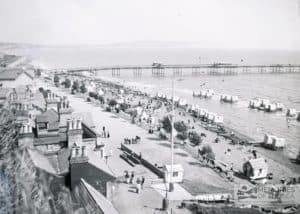Derek Stephens on Seaside
The Theatre as such was in the middle and do you remember Shanklin Pier at all or not?
Vaguely. I’ll show you something (laughs). That’s Shanklin Pier OK?
That was the ‘D’ that he used to park his Rolls-Royce in there and I mean this picture is from 1930, it’s quite an old picture, you can see by the cars, but I used to work for the Café on the beach.
When the storm came, that thing completely flipped over, the whole lot, and it tore all this with it and everything else and there was not a lot left of it. It sort of went up to about here then when it was finished and there was a concrete bit in the middle ‘cos in the middle, in the War they cut a lump out of the Pier like they used to do this in the War, they cut the all the Piers around the South.
Yeah, they cut a slot in them. They slotted the Pier so nobody could invade on the Pier. They thought the German Army was going to land on the Pier and make their way into Shanklin, you know? So, they cut a hole in the Pier. Now, troops don’t do that, they come on the beach don’t they? (laughs) But that’s what they done so they cut a great lump out of it.
When it came back, it was concrete so they … but I mean it was not done until the early ‘50’s so they built a whole little bar of concrete so it joined onto concrete and I suppose it was a bit difficult to join up a Pier somehow, and that’s where they had all these Bars and all the entertainment there. It was underneath.
That stayed there when it blew down, they had to dismantle that eventually but the rest of the Pier was basically rotten it it’s way because when we were working there one year, the Pier went ‘oomph’ one night and we said, “I wonder what that was?” What had happened, two of the piles of the Pier had gone down, so from those days on the Pier had sort of a bit of a slope and I mean they never done anything about it but I mean the trouble was it was never that maintained, this was the problem so all the bits under the water had been forgotten about and some of them had just gone.
Helen: They wouldn’t have thought about looking after things.
Well no, and this was the problem I think, when these gale force winds come in ’87, ’88, and there was nothing to keep it there, really. It had gone (laughs), I mean the winds were terrifically strong but it just took it away, and it put it all on the beach, just a long a bit, you know where the road goes down to the seafront, down the hill, it was all there on the beach. Everything, tons of it all on the beach. And people were there scavenging (laughs).
Yeah, that was a shame, that was almost a tearful day when that went. You know, it was the end of the life story basically there you know?
From that point on Shanklin seafront died, because that was the central point of it, that was the central part.
I mean now it’s just, I mean you’d still go down there but all you’ve got is that bit. It’s just that ‘D’, that’s all they’ve got and all the rest just went, you know?







